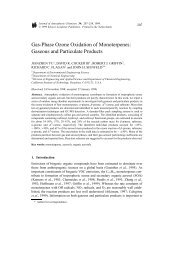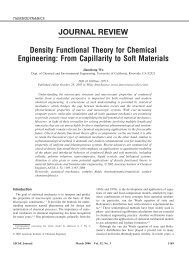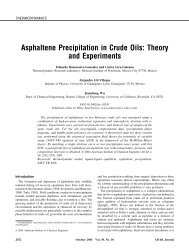DEVELOPMENT OF REVISED SAPRC AROMATICS MECHANISMS
DEVELOPMENT OF REVISED SAPRC AROMATICS MECHANISMS
DEVELOPMENT OF REVISED SAPRC AROMATICS MECHANISMS
You also want an ePaper? Increase the reach of your titles
YUMPU automatically turns print PDFs into web optimized ePapers that Google loves.
peroxy radical as shown above, it undergoes a cyclization reaction that should ultimately give rise to<br />
maleic anhydride:<br />
HC(O)CH=CHC(O)· → ┌OCH(·)CH=CHC(O)┐<br />
┌OCH(·)CH=CHC(O)┐ + O 2 → ┌OCH(OO·)CH=CHC(O)┐<br />
┌OCH(OO·)CH=CHC(O)┐ + NO → NO 2 + ┌OCH(O·)CH=CHC(O)┐<br />
┌OCH(O·)CH=CHC(O)┐ + O 2 → HO 2 + ┌OC(O)CH=CHC(O)┐ (maleic anhydride)<br />
The fact that the maleic anhydride yield is less than 100% is not inconsistent with this cyclization<br />
mechanism dominating because some of the reaction of OH with the 2-butene-1,4-dial proceeds via<br />
addition to the double bond, giving rise to other products. The <strong>SAPRC</strong>-07 mechanism<br />
estimation/generation system predicts that ~56% of the OH reaction proceeds via H-abstraction from<br />
HCO forming the species shown above, which is reasonably consistent with the observed maleic<br />
anhydride yields if the cyclization reaction dominates over acyl peroxy radical formation.<br />
The products formed in the photolysis of the model species representing the photoreactive ring<br />
fragmentation products are actually more important than those formed in the OH reaction because rapid<br />
photolysis is the major fate of these model species. The radical-forming photolysis mechanisms in<br />
<strong>SAPRC</strong>-07 are derived from the mechanism estimation system assuming that photolysis involves<br />
breaking the =CH--CHO and the =CHC(O)--H with approximately equal probability. This is almost<br />
certainly an oversimplification of the actual mechanism but available information on the product yields<br />
are not sufficient to derive an adequate alternative mechanism that explains the significant tendency of<br />
these reactions to form radicals when they photolyze (Calvert et al, 2002). The latter process was<br />
previously assumed to form acyl peroxy radicals and PAN analogues, but as discussed above it is<br />
probably more reasonable to assume it forms maleic anhydride. In addition, it is probably not reasonable<br />
to assume that scission of =CH--CHO bonds are important photodecomposition products of unsaturated<br />
1,4-dicarbonyls because if it were then one would expect the =CH--C(O)CH 3 scission to be equally<br />
important in the photolysis of unsaturated 1,4-diketones, but these compounds in fact do not appear to<br />
undergo photodecomposition to a significant extent (Calvert et al, 2002).<br />
Based on these considerations, we re-derived the representation of the monounsaturated<br />
dialdehyde or aldehyde-ketone ring-opening reactions assuming that the cyclization reaction forming<br />
maleic anhydride and analogous compounds is the main process for radicals such as HC(O)CH=CHC(O)·,<br />
and also that the photolysis forming radicals only involves scission of CO..H bonds. The latter<br />
assumption is also almost certainly an oversimplification, but at least it is consistent with the observation<br />
that an aldehyde group must be present in these 1,4-dicarbonyls for the compounds to be highly<br />
photoreactive. In terms of <strong>SAPRC</strong>-07 (and <strong>SAPRC</strong>-11) model species, the resulting mechanisms for the<br />
reactions of AFG1 and AFG2 with OH radicals, and for the photolysis of AFG1 forming radicals, are as<br />
follows:<br />
AFG1 or AFG2 + OH → 0.927 RO2C + 0.073 RO2XC + 0.073 zRNO3 + 0.756 xHO2 +<br />
0.026 xMEO2 + 0.146 xMECO3 + 0.336 xCO + 0.353 xRCHO + 0.129 xMEK +<br />
0.153 xGLY + 0.313 xMGLY + 0.212 xMEK + yR6OOH<br />
AFG1 + HV → HO2 + 0.927 RO2C + 0.073 RO2XC + 0.073 zRNO3 + 0.454 xHO2 +<br />
0.473 xMEO2 + 0.927 xMEK + yR6OOH<br />
The mechanism for the photolysis of AFG2, forming non-radical compounds represented by the model<br />
species PROD2, was not changed. Note that the <strong>SAPRC</strong>-07 model species MEK is used to represent<br />
maleic anhydride based on considerations of its reactivity.<br />
These revised AFG1 and AFG2 mechanisms were incorporated in a preliminary version of<br />
<strong>SAPRC</strong>-11, and the AFG1/(AFG1+AFG2) yield ratio were optimized for each compounds based on the<br />
26
















